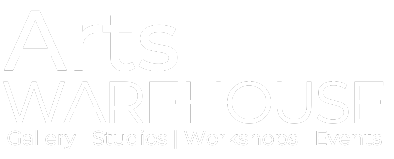By John Thomason – July 6, 2018
The Arts Warehouse’s newest exhibition, “Desert Triangle Print Carpeta,” features prints from artists living in three Americans cities—Tucson, El Paso and Albuquerque—all of which I’ve never visited. But if these printmakers’ work is any indication, they are strange places indeed, the kind of scorching, dusty, hallucinogenic climes where cultures clash, wild beasts roam and lurid symbolism flourishes.
In art, these environmental characteristics manifest in an excess of magical-realist, and full-on surrealist, fantasias. This exhibition is rife with serigraphs, lithographs, woodcuts and relief prints that boggle the mind, trick the eye and compel us to look harder, deeper, further. In the Desert Triangle, a figure’s midsection can grow a second head—its first head is covered with a paper bag—as it trudges through a landscape of giant paper boats, a hammer-wielding vulture and Death himself (Francisco Delgado’s “Lastima Margarito”). Elsewhere, a colorful bird provides shelter for scampering Lilliputians, which also frolic through openings in the heads and chests of normal-sized humans (Jorge Perez’s “Presa es la Frotera, la Frontera te Apresa,” pictured at top of this post). Keep visiting, and you’ll spot a dog urinating—sort of—on the shoe of a person whose hands have grown eyes and teeth (The Jellyfish Colectivo’s “Recargado sobre el Borde,” a hilarious piece, and one of the my favorites in the exhibition).
The impossibilities appear limitless, in other words, and it’s amazing how many of the 30 artists in “Desert Triangle” got this memo. Maybe there’s something in the water over there—or maybe it’s the openness of the landscapes, the relative lack of subdivisions and Subways compared to, say, South Florida. Whatever the reason, these works have imagination to spare. They’re full of life and death and everything in between.
Because the Mexican-American population is so high in the triangle, Day of the Dead-style imagery prevails on several of the paintings, like Pavel Acevedo’s intricate “Black Biel,” with a skull and flowers framing a pair of conjoined heads. Manuel Guerra’s ghoulish litho “Se Queman los Aguacates” marries Mexican symbolism with Bosch-like hedonism, as a skull-headed figure mounts a woman from behind, while a humpbacked creature, in turn, mounts it. Lauren Mann’s “Final Thoughts Before the Reconstruction” is a hellscape worthy of Dante, in which bodies’ extremities—hands, feet and heads—have been stripped away, leaving behind meandering midsections.
Other artworks are friendlier or more benign in nature, like Martin Quintanilla’s “El Ultimo Taco,” a “Last Supper”-style gathering of characters that is convivial and ceremonial, and Matthew Poe’s “Ole,” a cubist riff on bullfighting culture. Tim Razo’s endlessly fascinating “Enigmatic Ascending Society” is a whimsical evocation of geometric futurism that combines M.C. Escher and “The Jetsons,” Jacques Tati and Brad Bird. And Rich Rogowski’s “Lineup” strikes a peculiar balance between humor and deviance, depicting a Red Light District of exaggerated prostitutes gesticulating for the viewer.
What just about every work in “Desert Triangle” boasts is a sense of surprise, a direct result of the artists’ retreats from normality. This sense of heightened subjectivity is never stronger than in the exhibition’s most technologically advanced works: “augmented reality” serigraphs made three-dimensional through the use of iPads supplied under each print. In Tanya Rich’s portrait “Receive the Desires in Your Heart,” the subject blinks, and the red flowers blooming around her face float toward us in a trippy loop of vibrant color. Zeke Pena’s “A Nomad in Love” is wilder: A face with spirals for eyes jerks this way and that, finally settling back on its neck like a quiescent bobblehead, while a hummingbird beats its wings at the bottom of the frame, and rabbit a swirls like a pinwheel in the upper-right quadrant.
When I was learning how to drive, “expect the unexpected” became a mantra to live by; it’s also an ideal mindset to approach this remarkable, culturally insightful exhibition.
“Desert Triangle Print Carpeta” opens today, July 6, with a reception from 6 to 9 p.m. that will include artist demonstrations. It runs through Aug. 11. Admission is always free. Arts Warehouse is at 313 N.E. Third St., Delray Beach. For information, call 561/330-9614 or visit artswarehouse.org.



